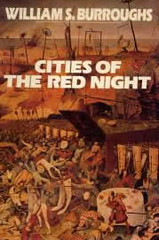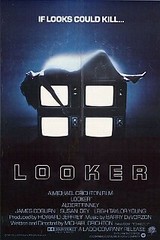
Cover art of Cities of the Red Night depicting Brueghels “The Triumph of Death“.
I read Cities of the Red Night this July while in Spain; I had to let it ferment for a while and unfurl it. it was a profound reading experience; and my first semi-sustained one after my first and only aborted attempt to read Burroughs by way of Naked Lunch.
I have the fondest memories of Burroughs in Drugstore Cowboy, and his Gus Van Sant-directed appearance on MTV with Thanksgiving Prayer[1] (unavailable in Europe).
Cities of the Red Night stated that spontaneous ejaculation is a heroin withdrawal symptom. This caught my attention. Today, I looked it up and it is apparently confirmed by medical literature. The novel is the perfect introduction to Burroughs’s whole language is a virus trope, later adopted by the likes of Laurie Anderson, Steven Shaviro and other postmodernists.
From my wiki:
Cities of the Red Night is a novel by William S. Burroughs. It was the first book in the final trilogy of the beat author, and was first published in 1981. Drugs play a major part in the novel, as do male homosexuality. The plot of this non-linear work revolves around a group of revolutionaries who seek the freedom to live under the articles set out by Captain James Mission. At the same time in near present day, detective Clem Snide is searching for a lost boy, abducted for some sort of sexual ritual. Another subplot weaved in thematically through the narrative is a world plagued by a fictional disease, Virus B-23, that destroys humanity and is sexually transmitted and sexual in nature, causing for example spontaneous orgasms. Addiction to opiates provides some resistance to it. The disease is viral, and, at first, it appears to be an allusion to AIDS, although, it must be remembered that the first case of AIDS was not discovered until after the book was first published.
See also:’the cities of the red night were six in number, alternate history, Dr Benway, Nothing is True, Everything is Permitted
Finally, whence the quote came:
“Self-identity is ultimately a symptom of parasitic invasion, the expression within me of forces originating from outside. Language is to the brain as the tapeworm is to the intestines. Even more so: it may just be possible to find a digestive space free from parasitic infection, but we will never find an uncontaminated mental space. Strands of alien DNA unfurl themselves in our brains, just as tapeworms unfurl themselves in our guts. Not just language, but the whole quality of human consciousness, as expressed in male and female is basically a virus mechanism.” —Cities of the Red Night

Triumph of Death (1562) – Pieter Brueghel the Elder




















